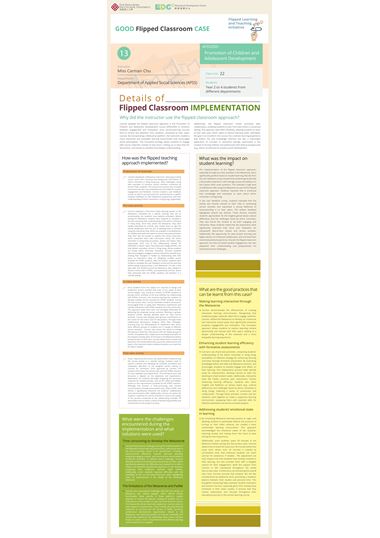
General Information
- Instructor: Miss Carman CHU
- Department: Department of Applied Social Sciences
- Subject: APSS2S05 Promotion of Children and Adolescent Development
- Class size: 22
- Students: Year 2 to 4 students from different departments
Why Use the Flipped Classroom Approach?
Implementation Steps
Carman developed a Metaverse classroom, featuring multiple virtual rooms that contained the background information of ethnic minorities in Hong Kong (e.g., daily challenges), along with examples of previous service activities conducted by former PolyU students. The virtual environment also included interactive tools like virtual whiteboards and Padlet for student engagement and feedback. Carman created a user feedback survey, as well as pre-and post-test questionnaires to gather students’ feedback on their Metaverse experiences, and their understanding of ethnic minorities in Hong Kong, respectively.
Pre-class activity
Carman organised a 30-minute online learning session in the Metaverse, scheduled for a specific evening time slot to accommodate her students' busy daytime schedules. Before joining the Metaverse, students were required to complete a pre-test assessing their understanding of the ethnic minorities in Hong Kong. Once they joined the Metaverse, they were initially welcomed by Carman who invited them to sign the virtual whiteboard, with the aim of allowing them to practice using the interactive tools, which are available in the Metaverse, for collaboration with their peers in various interactive activities. They then had 30 minutes to explore the virtual classroom, which presented them with information about the ethnic minorities in Hong Kong via posters, photos and videos. Most importantly, since one of the collaborating schools for APSS2S05 is Islamic Kasim Tuet Memorial College (IKTMC), the only Muslim secondary school in Hong Kong, whose students are mostly ethnic minorities. Therefore, Carman’s students were encouraged to engage in various interactive activities (e.g., sharing their thoughts in Padlet) by collaborating with their peers to brainstorm ideas for designing suitable service activities for IKTMC students. After the session, students were invited to complete the user feedback survey and the post-test before taking a group photo in the Metaverse. Of note, a few days after the students joined the Metaverse, they needed to attend a school visit in IKTMC, accompanied by Carman, where they interacted with the IKTMC students and teachers in a real-life setting.
In-class activity
Since students from this subject are required to design and implement service activities that cater to the needs of their service targets (e.g., acting as a mentor of IKTMC students to provide escort activities to the local elderlies by collaborating with NGOs), Carman’s role involves assisting her students to develop suitable service activities for IKTMC students. During the face-to-face class, Carman facilitates student discussions, encouraging them to apply their Metaverse experiences and real-life interactions with IKTMC students from the school visit. This approach helps them plan and strategise effectively for delivering the proposed service activities. Working in groups, students further develop detailed plans for their service activities. Carman then displays each group’s contributions on the screen for the entire class for discussions. Through these collaborative discussions, students refine their strategies, ensuring they are well-prepared to implement their plans. Since different groups of students are in charge of different service activities, Carman also assists the person-in-charge (PIC) group to lead their discussions with the helper groups to further consolidate their collaboration and leadership skills. As the students already spent 30 minutes in the Metaverse before joining the face-to-face class, Carman allows them to leave the classroom 30 minutes before the usual time, while Carman still stays in the classroom where individual students can reach her for help if needed.
Post-class activity
As per required by the course, two weeks before implementing the service activity in a real-life setting, students need to submit a session plan detailing the schedule, procedure and manpower allocation of the assigned service activity to Carman for comments. Once approved by Carman, her students then share the session plan with the IKTMC teachers for their feedback and adjustments. This will help ensure that everyone is aligned on the objectives and expectations. Meanwhile, her students will begin preparing the necessary materials for related activities, such as PPT slides and leaflets, based on the requirements provided by the IKTMC teachers. Although this process is time-consuming and involves communication among various parties (e.g., PolyU, IKTMC, and NGOs), it significantly enhances the students' collaboration and communication skills. Additionally, Carman can assess the students' readiness for service activities to ensure the quality of the services conducted at the collaborating school(s). All these efforts aim to foster a sense of shared responsibility and commitment to the project's success.
What Impact Did This Have on Student Learning?
The implementation of the flipped classroom approach, especially through pre-class activities in the Metaverse, had a significantly positive impact on student learning. Results from the user feedback survey showed that students generally had a favourable experience, with average scores exceeding 4 on the 5-point Likert scale questions. This indicates a high level of satisfaction with using the Metaverse as part of the flipped classroom approach. Students reported that it enhanced their knowledge and motivation to learn about ethnic minorities in Hong Kong.
In the user feedback survey, students indicated that the activity was directly relevant to their roles in conducting service activities and expressed a strong likelihood of recommending it to their peers. The written feedback highlighted several key themes. These themes included students' appreciation for the insights gained about cultural differences and the challenges faced by ethnic minorities. They also found the module to be both engaging and interactive. Many students noted that the preparatory work significantly improved their focus and motivation for subsequent face-to-face classes and service activities. Additionally, the opportunity for peer-to-peer learning was highly valued, as it fostered collaboration and enriched their overall educational experience. Overall, the flipped classroom approach not only increased student engagement, but also deepened their understanding and preparedness for real-world service challenges.
What Are the Good Practices That Can Be Learnt from This Case?
Carman demonstrated the effectiveness of creating interactive learning environments. Recognising that traditional paper materials often fail to engage students, Carman utilised the Metaverse to develop an immersive and interactive virtual space that significantly enhances students’ engagement and motivation. This innovative approach allows students to explore teaching content dynamically and interact with their peers, leading to a deeper understanding of the materials and a more enjoyable learning experience.
Enhancing student learning efficiency with formative assessments
Carman's use of pre-and post-tests, comparing students’ understanding of the ethnic minorities in Hong Kong, exemplifies an effective strategy for enhancing learning outcomes through formative assessment. By evaluating knowledge before and after the Metaverse sessions, she encourages students to actively engage and reflect on their learning. This collaborative process helps identify areas for improvement, allowing Carman to tailor her teaching to meet student needs. Additionally, interactive tools like Padlet, promote peer interactions, further enhancing learning efficiency. Students also share insights and feedback on various topics (e.g., cultural differences and challenges faced by ethnic minorities in Hong Kong), fostering a sense of community and collaboration. Through these activities, Carman and her students, work together to create a supportive learning environment, equipping them with essential skills for effective teamwork and service-oriented projects.
Addressing students’ emotional state in learning
By scheduling Metaverse learning sessions at night, and allowing students to participate without the pressure of turning on their video cameras, she created a more comfortable learning environment. This approach acknowledged the emotional states of her students, reducing anxiety and making them feel more at ease during the learning process.
Additionally, since students spent 30 minutes in the Metaverse before joining the face-to-face class, Carman allows them to leave the classroom 30 minutes before the usual time, where such 30 minutes is treated as consultation time, that individual students can reach Carman for assistance, if needed. This adjustment not only respects the time students have already invested in their learning, but also provides them with a tangible reward for their engagement, while the support from Carman is still maintained throughout the whole face-to-face class. Furthermore, by shortening the overall class time, Carman ensured that students did not feel overwhelmed by additional work, promoting a healthier balance between their studies and personal time. This thoughtful scheduling helps maintain student motivation and prevent burnout, especially given their already busy schedules in their major studies. It ensures that they remain enthusiastic and focused throughout their educational journey in the service-learning course.
What Were the Challenges Encountered During the Implementation and What Solutions Were Used?
Carman faced several challenges during the implementation of the Metaverse-based learning environment, particularly due to the time-consuming nature of its development. Creating a well-structured Metaverse required extensive planning, designing engaging content, and ensuring the virtual platform functioned smoothly. To address these challenges, Carman attended professional development workshops at PolyU, which significantly alleviated her difficulties and enabled her to offer a unique and impactful educational experience to her students, surpassing what traditional methods might achieve. Additionally, some students reported difficulties with the readability of text on the virtual classroom walls, highlighting areas for improvement in the design of the Metaverse classroom.
The limitations of the Metaverse and Padlet
Carman also encountered challenges with the free version of Metaverse and related gadgets, which offered limited functionality. Many sections of these platforms require payment to unlock full features, leading to hurdles such as restrictions on the number of users and time limits for access. To enhance the virtual classroom experience, Carman plans to seek support in several areas. These include securing financial assistance to purchase the full version of Padlet, accessing professional development opportunities related to the Metaverse, and exploring solutions to improve readability and overall user experience. By addressing these issues, Carman hopes to create a more comprehensive and effective learning environment for her students.

